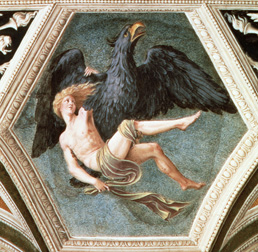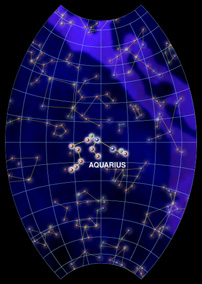Aquarius, the Waterbearer. If you look closely, you may see what looks like a boy dangling down from the sky.
Click on image for full size
Windows to the Universe original image
Aquarius
Aquarius is a member of the Zodiac, a group of constellations that the Sun travels through each year. It is best viewed in the fall in the southern sky, although much of the northern hemisphere can see the Waterbearer in the spring. Aquarius is one of the oldest constellations in the sky.
In Greek myth, Aquarius was Ganymede, the young boy kidnapped by Zeus. Zeus sent his eagle, Aquila, to snatch Ganymede out of the fields where the boy was watching over his sheep. Ganymede would become the cupbearer for the Olympian gods. The constellation, Crater, is often thought to be Ganymede's cup.
The Sumerians also believed that Aquarius brought on a sort of global flood. Also, many of the stars that make up Aquarius have names that refer to good luck. This is most likely due to the time of year when the Sun would rise in Aquarius. It happened to be at the same time when the rainy season began in the Middle East.
You have to use some imagination to see a figure of a boy in the sky. Look at the constellation in the same position as the one pictured. The head is on the right end. Moving left, you can see what could be an arm dangling down. Continue left more, and you come to the lower half of the body. Notice the legs are bent. This may represent the position of Ganymede while being carried by Aquila to Mount Olympus.
There are three globular clusters in Aquarius that may be viewed through a small telescope. The planetary nebula, named the Saturn Nebula, is also in the Waterbearer.. It is so named because it looks like the planet Saturn when viewed through a telescope. The closest and brightest planetary nebula is the Helix Nebula, located directly east of the "foot".
You might also be interested in:

If you think that this globular cluster looks like a very round elliptical galaxy, you would be right! Elliptical galaxies and globular clusters have a lot in common. There is no gas or dust in a globular
...more
Why would we call nebulae stardust? Because the gas in nebulae is used to make new stars, and dying stars create nebulae from their gas. While stars are made of very hot, dense gas, the gas in nebulae
...more
Ganymede was a son of Tros, first king of the classical land known as Troy. He tended sheep there on the slopes of Mount Ida. One day Jupiter caught a glimpse of the young boy and was overwhelmed with
...more
Many different constellations fill the evening sky in the northern hemisphere. Depending on your location and the season, different constellations can be seen. Northern circumpolar constellations can be
...more
Many different constellations fill the evening sky in the southern hemisphere. Depending on your location and the season, different constellations can be seen. Southern circumpolar constellations can be
...more
The constellation Carina is known as the Keel, which is the bottom part of old ships. Carina was originally a part of Argo Navis, which was a huge boat in the night sky. It has since been divided into
...more
In most cases, however, the stars that we see that seem to be "close" to each other actually are quite far apart, some stars are much closer or farther than others as is shown in the example below of Ursa
...more
In our time, scientists (and most people!) know that the constellations seem to move across the sky because the earth rotates on its axis. What, you may ask, does the turning of the earth have to do with
...more















